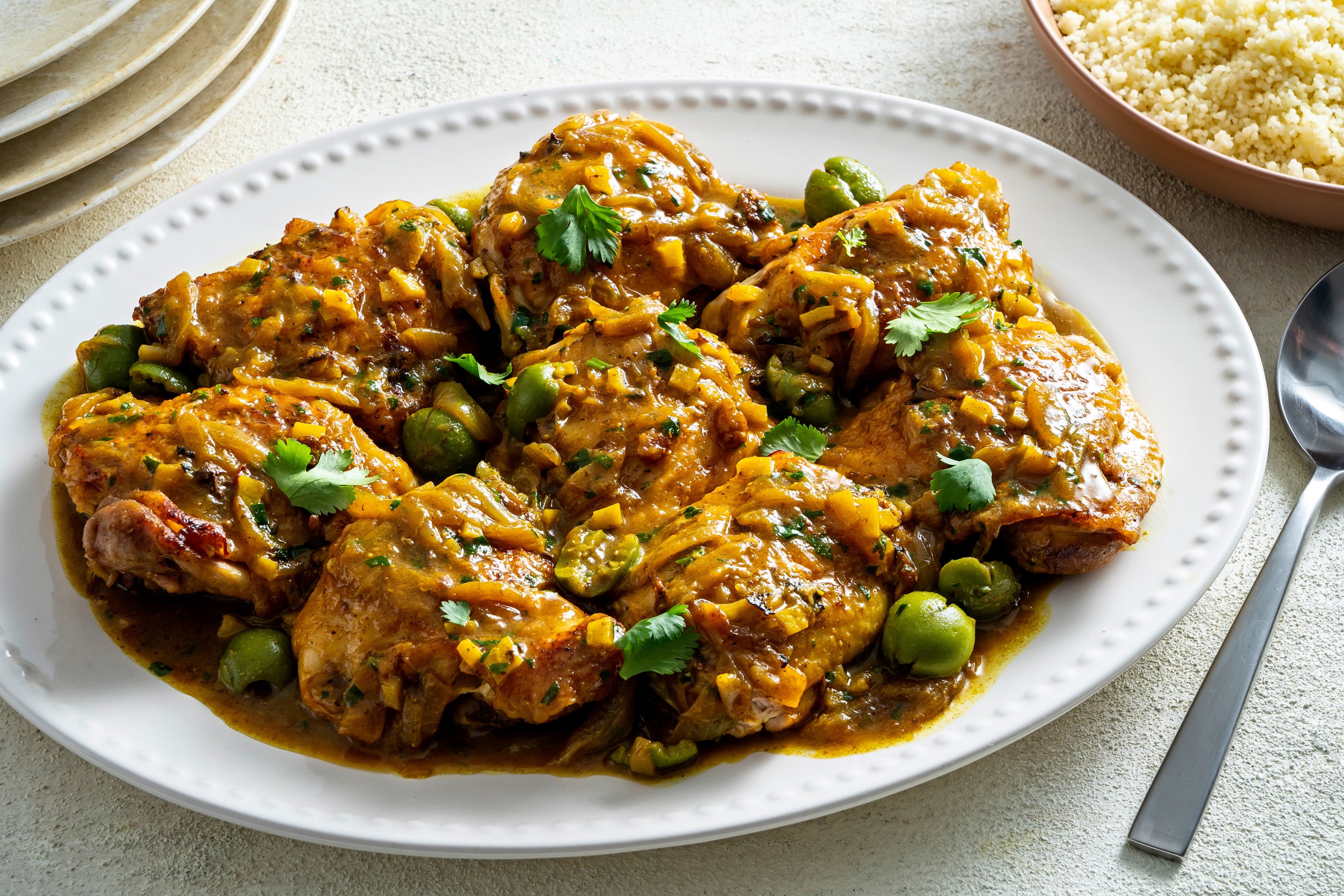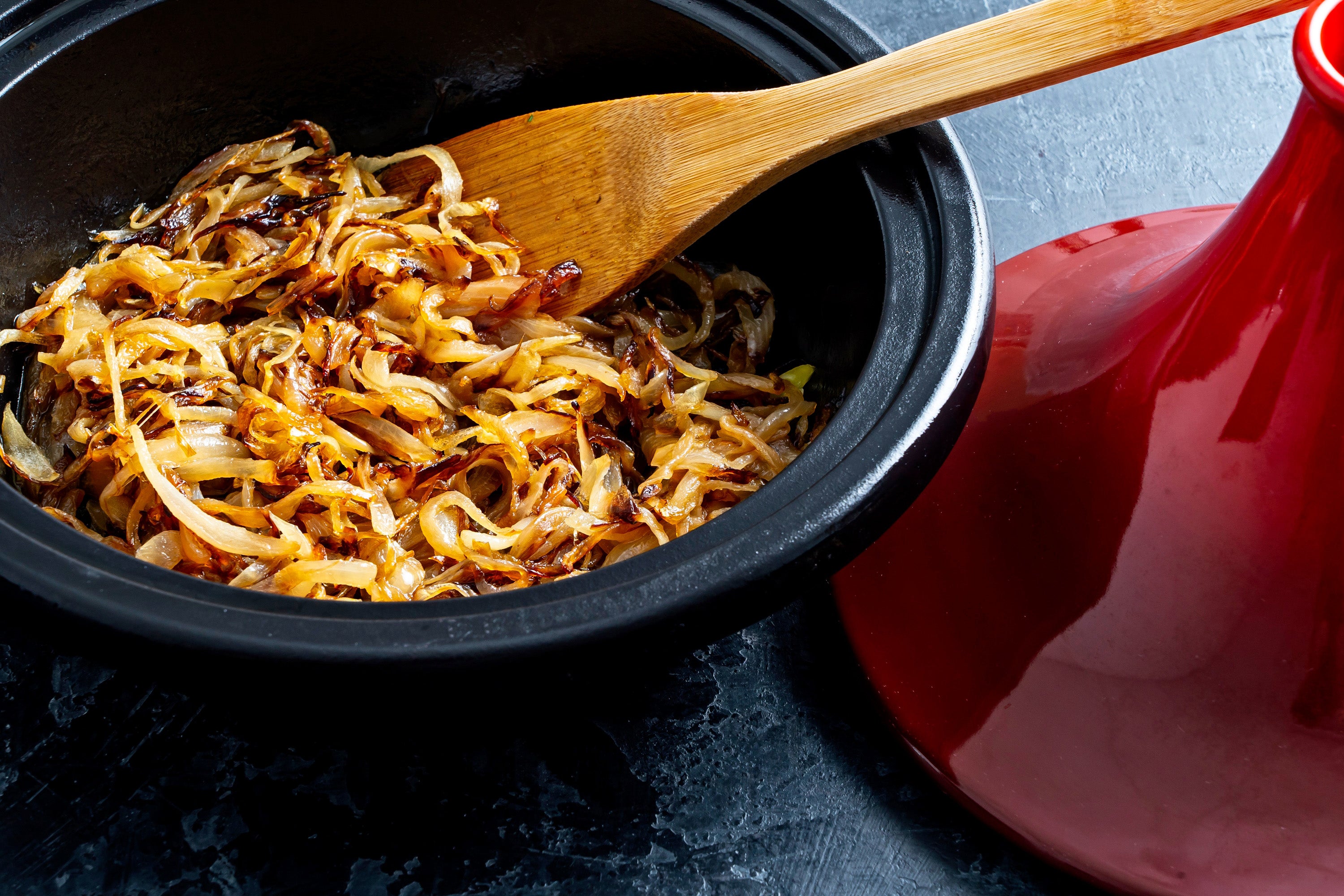You can and should make tagine at home – here’s why and how
This Moroccan chicken stew, a tagine with olives and preserved lemon, is as comforting as it is fragrant, writes Olga Massov

I tasted my first tagine in my 20s. A newly minted New Yorker, I went out to dinner in Greenwich Village to a now-shuttered restaurant called Cookies and Couscous. While sitting by the window and sipping mint tea, my friend and I studied the menu, admired the tiny 20-seat space, and ordered tagines – lamb and chicken – and a bottle of Moroccan red wine.
We smelled our tagines before we saw them, the heady aroma announcing their arrival. The stews, perfumed with saffron, ginger and coriander, among other spices, were as delicious as they were aromatic. Alongside couscous, it was an unforgettable meal, one I’ve thought about ever since.
And yet, for no other reason than intimidation, until recently I had never attempted to make a tagine at home. I’m now here to tell you: don’t be like me; make a tagine at home.
Most associated with Morocco, tagine is the name of a dish as well as the vessel in which it is cooked. The latter has a circular base with low sides and a hatlike dome lid in which ingredients are slow-cooked or braised. The lid’s conical shape allows moisture to condense and return to the pot, keeping the dish moist.
Traditionally, tagines were made out of clay to cook gently over a dying fire. Commonly, a kanoun (brazier) is used to gently diffuse the heat (I used it in the recipe below and recommend it heartily). These days, contemporary tagines by brands such as Le Creuset are made with a cast-iron base and designed for use in home ovens.
Tagines can be made with vegetables, poultry, meat or seafood, and they are typically served alongside couscous. The recipe below, adapted from San Francisco-based Moroccan chef Mourad Lahlou’s cookbook, Mourad, uses chicken, as well as olives and preserved lemon. (A quick aside: some recipes will tell you that plain lemons are a fine substitute for preserved. Don’t believe them. In a pinch, a lemon will add brightness and acid, but the salty, briny notes imparted by preserved lemons cannot be replicated. Seek them out at well-stocked supermarkets or Middle Eastern markets.)
The version below is exquisitely fragranced. The word m’qualli, according to cookbook author Claudia Roden in her book Arabesque, denotes tagines “cooked in oil where there is saffron and ginger and the sauce is yellow”.
You will notice that Lahlou’s version finishes the dish with butter. This is where the chef flexes his culinary training by employing a few French techniques, but the recipe remains straightforward and achieves deeper flavour with just a few minutes of extra effort.
He first instructs you to sear the chicken on both sides in a little olive oil (or rendered chicken fat, if you have it). This step produces some splatters, so wear an apron, and if you have a splatter guard, use it (the results are so fantastic, however, that I, an inveterate splatter hater, don’t mind the mess). Once the chicken is generously browned, set it aside, pour off most of the fat, and cook what appears to be an ungodly amount of onions until they are the colour of an Irish setter and are soft, yielding and on the brink of caramelisation.
Now the aromatics come in: into this heap of schmaltzy onions you stir a mix of coriander, white pepper, ginger, saffron and turmeric. The aroma alone will render you weak-kneed, but you’re not done just yet. Return the chicken to the tagine, nestling it into the onions, add the broth and bring it all to a simmer. Then the domelike lid goes on top and the vessel moves to the oven to braise.
When the chicken is cooked, you finish the dish on the stovetop by enriching the sauce with the olives and preserved lemon, while Lahlou’s nontraditional addition of butter rounds out the sauce, giving it dimension and complexity.
What if your kitchen, like many, lacks a tagine? Don’t fret. Any heavy-bottomed pot of similar volume – a casserole dish, for instance – will ably do the job. In fact, if you’re planning to make this braise for a crowd, you need to look for something that can fit more food, as the former is meant for smaller yields. I suspect that on the night of my first tagine tasting, a larger batch was cooked in a big pot to serve multiple customers, which would technically have made the dish qdra (named for the big pots used for larger parties), and then parceled out into a tagine for a beautiful presentation.
Whatever your vessel, the rich blend of spices, olives and preserved lemons will result in a delicious braise that just might become a beloved recipe in your home, too.
Djaj m’qualli (chicken, olive and lemon tagine)

Active time: 50 minutes
Total time: 1 hour 35 minutes
Serves: 6 to 8
This Moroccan chicken stew, a tagine with olives and preserved lemon, is as comforting as it is fragrant. Tagine, named for the clay vessel in which it is traditionally cooked, is a dish that dates to the late 8th century. A tagine pot has a round bottom and a hat-like lid, which allows the air to circulate similar to a convection oven.
Traditionally served with couscous, this version also could be served with long-grain white rice, if you prefer.
Storage: Refrigerate for up to 4 days.
Where to buy: Preserved lemons can be found at well-stocked supermarkets or Middle Eastern stores.
Ingrdients
8 bone-in skin-on chicken thighs (about 1.4kg total), patted dry
Fine salt
Freshly ground black pepper
1 tbsp olive oil, plus more as needed
680g yellow onions, halved and thinly sliced
2 tbsp ground coriander
2 tsp ground white pepper
2 tsp ground ginger
1 tsp saffron threads
½ tsp ground turmeric
300ml unsalted chicken broth
Rind of 1 preserved lemon, chopped
About 10 green olives, pitted and cracked
2 tbsp unsalted butter
1 tbsp chopped or whole leaves of fresh flat-leaf parsley (optional)
1 tbsp chopped or whole leaves of fresh coriander (optional)
Cooked couscous, for serving (optional)
Method
1. Generously season the chicken on all sides with salt and pepper and let sit at room temperature for 1 hour, or refrigerate overnight.
2. When ready to cook, in a tagine or casserole dish over medium-high heat, heat 1 tablespoon of oil until shimmering. Working in batches, if necessary, add half of the chicken, skin side down, and cook, turning once, until well browned, 3 to 5 minutes per side. Transfer to a platter and repeat with the remaining chicken, if needed. This can be messy; if you have a splatter guard, use it.
3. Position a rack on the bottom of the oven (remove the other racks so the tagine or casserole dish can fit) and preheat to 180C.
4. Reduce the heat to medium and pour off all but about 2 tablespoons of the fat in the pan (if the fat burned, discard it and add 2 tablespoons of oil). Add the onions and cook, stirring often and adjusting the heat as necessary so the onions don't burn, until rich golden brown, 12 to 15 minutes.
5. Season the onions with the coriander, white pepper, ginger, saffron and turmeric, add a pinch of salt, and cook, stirring, until the spices are slightly toasted, about 90 seconds. Return the chicken to the tagine or casserole dish, pour in the chicken broth and bring to a lively simmer.
6. Cover the tagine or casserole dish, transfer to the oven and braise for 40 minutes, or until the chicken is tender and starts to fall off the bone. Using a slotted spoon or tongs, transfer the chicken to a platter, cover to keep warm, and return the tagine or casserole dish to the stovetop. Turn the heat to low and simmer the sauce until it's slightly reduced and coats the back of a spoon, about 6 minutes. Add the preserved lemons and olives and cook until warmed through. Whisk in the butter and herbs until the butter melts. Taste, and season with more salt, if desired. Remove from the heat, cover and let sit for 5 minutes.
7. Spoon the sauce, lemons and olives over the chicken, garnish with more parsley and/or coriander, if using, and serve with the couscous.
Nutrition information per serving (1 chicken thigh), based on 8 | Calories: 344; total fat: 26g; saturated fat: 8g; cholesterol: 121mg; sodium: 245mg; carbohydrates: 2g; dietary fibre: 1g; sugar: 1g; protein: 24g.
This analysis is an estimate based on available ingredients and this preparation. It should not substitute for a dietitian’s or nutritionist’s advice.
© The Washington Post
Join our commenting forum
Join thought-provoking conversations, follow other Independent readers and see their replies
Comments
Bookmark popover
Removed from bookmarks